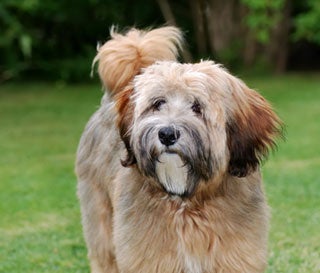Learn about dog breeds
Detailed information & photos on over 190 different breeds
Description
In the past, terriers were kept for their superb abilities to hunt down rats and rodents. Today, these dogs are more used for their companionship characteristics and their abilities in herding.
Belonging to the terrier line, the Tibetan Terrier is a dog that is average in size but similar to the Shih Tzu. This can be attributed to the fact that it was one of the breeds used in earlier breeding programs for Shih Tzus. In appearance, it has hair all over the face and this provides protection from all elements. Its hind legs are powerful while its long and straight outer coat can be in a variety of colors. Its long and tufted tail has a tendency to fall on its back. One of the most outstanding features of the Tibetan Terrier is its very flat and rough feet. Possessing these characteristics, the Tibetan Terrier can go through rough terrains with ease.
Coat Description
The Tibetan Terrier has two coats; the inner short and smooth coat and the outer long, but straight coat. Its coat can be in numerous colors like gray, golden, black or cream. However, liver and chocolate are not the recognized colors of the Tibetan Terrier.
History
In the early 1900s, the Tibetan Terrier was introduced to the West. When a surgeon saved her life, an Indian woman gave a Tibetan Terrier to her savior as a gesture of gratitude. Delighted with the rare dog, the surgeon began showing the Tibetan Terrier in various dog shows. Though this Terrier was new to the West, it already had a rich history in the East. It was used as a companion for monks and for herding. In the early days, the Tibetan Terrier was never sold. Lucky owners were those who received it from the monks or as a gift of gratitude from another owner.
Temperament
If you are thinking of owning the Tibetan Terrier, you have to know that it needs a great deal of companionship. If this dog is left alone, it may end up suffering from behavioral problems out of loneliness. The great thing is that you won’t mind spending time with the Tibetan Terrier as it is very intelligent and can easily be trained.
Being a sociable breed, the Tibetan Terrier loves making friends. However, you have to be prepared for the first year as this is the period of time when it may be a bit challenging to handle the Tibetan Terrier. As a great observer, it can learn how to get out of locked rooms by watching your actions. You can overcome these tendencies by touching the dog’s sense of intelligence and curiosity. The Tibetan Terrier is sensitive to the human touch. This is why it is important that you get to know the dog slowly and carefully and not by force.
When compared to other dogs, the Tibetan Terrier is a dog that takes some time to mature. You have to spend lots of time in training it and introducing different levels of physical contact. Once this is done, the dog will trust you and start behaving obediently.
Health Problems
Generally, the Tibetan Terrier is a healthy dog. However, there are some hereditary problems that you will find like canine hip dysplasia, lens luxation and progressive retinal atrophy. You have to make it a habit to get its eye checked periodically for genetic problems as the breed has a predisposition to eye problems.
Grooming
As the Tibetan Terrier has a long and beautiful coat, it requires regular grooming. It is during the tenth to fourteenth months of age that it needs more grooming as this is when there is a change in its coat as it reaches physical maturity. It is easier and better for you to use some water or conditioner to wet its coat prior to brushing. The grooming of the Tibetan Terrier needs more emphasis on its beard, feet and leg joints.
Don’t forget to ensure that any hair found in between its foot pads are removed periodically. One great thing about the Tibetan Terrier is that with regular brushing, it has sheds less.
Exercise
Another important point to remember before getting yourself a Tibetan Terrier is that this is a dog that requires a hectic, daily exercise routine. In the Himalayas, the Tibetan Terrier used to roam the mountains and wilderness so its affinity for adventure and exploration is very high.
Just taking the dog for a walk is not sufficient; you have to let it run around outside a minimum of two times a day. This will allow it to release its pent up energy. Without exercise, this pent up energy can turn out to be destructive.
So it is not advisable to have a Tibetan Terrier if you live in a flat. It is best that you have a yard which is big enough for your Tibetan Terrier to run and touch part of its inherent nature to be wild.
Training
When you are training your Tibetan Terrier, make sure you use positive reinforcement. If you scold or threaten it, it will go against you, rendering your training a failure. Offer treats when the dog behaves well, and it will solve many of the heartaches of obedience training.
Once you start a training program for the dog, you have to be consistent in your training. If you waver, the dog will not perform or learn as well as it can. It is mandatory that the dog knows what it has to do to be rewarded. Don’t let it convince you into rewarding it before doing its work.
Advertise | Privacy Policy | Terms of Use | Contact Us © Copyright 2004-2024 PupCity.com. All rights reserved.
